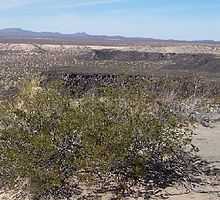Larrea
From Wikipedia, the free encyclopedia
| Larrea | |
|---|---|
 | |
| Larrea tridentata | |
| Scientific classification | |
| Kingdom: | Plantae |
| (unranked): | Angiosperms |
| (unranked): | Eudicots |
| (unranked): | Rosids |
| Order: | Zygophyllales |
| Family: | Zygophyllaceae |
| Subfamily: | Larreoideae |
| Genus: | Larrea Cav. |
| Species | |
| |
| Synonyms | |
|
Covillea Vail | |
Larrea is a genus of flowering plants in the caltrop family, Zygophyllaceae. It contains five species of evergreen shrubs that are native to the Americas. The generic name honours Spanish scientist J.A. Hernández Pérez de Larrea.[2] South American members of this genus are known as jarillas and are so closely related that hybrids are partially fertile. One of the more notable species is the Creosote Bush (L. tridentata) of the southwestern United States and northwestern Mexico The King Clone ring in the Mojave Desert is a Creosote Bush clonal colony estimated to be 11,700 years old.
Species
- Larrea ameghinoi
- Larrea cuneifolia
- Larrea divaricata Cav.
- Larrea nitida
- Larrea tridentata (DC.) Coville – Creosote Bush[3][4]
References
- ↑ "Genus: Larrea Cav.". Germplasm Resources Information Network. United States Department of Agriculture. 2007-10-05. Retrieved 2010-10-08.
- ↑ Couplan, François (1998). The Encyclopedia of Edible Plants of North America. McGraw-Hill Professional. p. 312. ISBN 978-0-87983-821-8.
- ↑ "GRIN Species Records of Larrea". Germplasm Resources Information Network. United States Department of Agriculture. Retrieved 2010-10-08.
- ↑ "Larrea". Integrated Taxonomic Information System. Retrieved 2010-10-08.
- T. J. Mabry, J. H. Hunziker, and D. R. Di Feo, D. R. (Eds.). Creosote Bush: Biology and Chemistry of Larrea in New World Deserts US/IBP Synthesis Series N° 6 (Dowden, Hutchinson and Ross, Inc. PA, 1977)
- Juan H. Hunziker and Cecilia Comas, "Larrea interspecific hybrids revisited (Zygophyllaceae)" Darwiniana, 40(1-4): pp. 33-38 (2002)
External links
![]() Media related to Larrea at Wikimedia Commons
Media related to Larrea at Wikimedia Commons
![]() Data related to Larrea at Wikispecies
Data related to Larrea at Wikispecies
This article is issued from Wikipedia. The text is available under the Creative Commons Attribution/Share Alike; additional terms may apply for the media files.